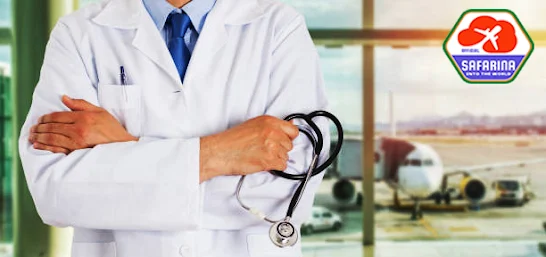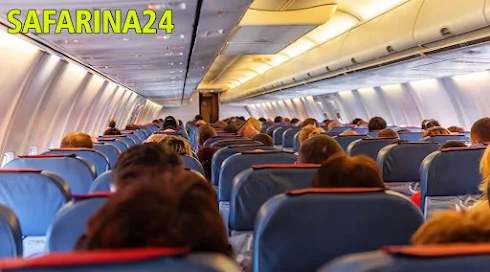How to deal with medical emergencies on board
Table of contents:
Common medical emergencies that may occur on board
How medical emergencies are handled on board a commercial airline
What medical equipment is available on commercial aviation
Why is it advisable to take a medical escort on board a commercial flight
What types of services can medical escorts provide while traveling
Air ambulance as an alternative option: and what are its advantages
The last thing you want to think about while traveling to your summer vacation destination is getting sick on the plane. However, medical emergencies in the air are more common than you think. How will you behave if you lose consciousness, suffocate or get sick during the flight This article describes how to deal with medical emergencies on commercial aircraft. Read the article to the end to find out how we organize our medical flights to meet the needs of passengers with serious illnesses and injuries.
Common medical emergencies that may occur on board
The most common in-flight medical emergencies include:
Seizures
Heart disease.
Vomiting and nausea
Respiratory problems
Dizziness and fainting
Rare in-flight medical emergencies include
Ear pain
Headache
Wounds and injuries
Cardiac arrest
Obstetrics and gynecology
According to a study published in the New England Journal of Medicine, a medical emergency occurs on almost one in 600 commercial flights, that is, approximately 44,000 flights a year worldwide, which means that airlines must be prepared to deal with medical emergencies that occur on commercial flights.
9 things that are forbidden to take on the plane in your suitcase
Medical emergencies during flights are classified into two types: health-related and injury-related. Digestive problems, allergic reactions, shortness of breath, heart attacks and strokes are all examples of health-related problems. Anxiety about the trip, nausea, fainting can also lead to serious consequences. In extremely rare cases, food poisoning or infectious diseases can affect several passengers at the same time and getting burns or burns from contact with kitchen ovens, hot liquids, a melee on board, falling luggage from an overhead container, or air turbulence can also lead to injuries.
Moreover, altitude may increase the risk of medical accidents during the flight, while airlines do their best to adjust the pressure inside their cabin, but it is not necessarily equal to the standard pressure level at sea level. That is, simply put, you breathe dry air and as a result, passengers with underlying medical problems, such as cardiovascular or respiratory diseases, are more likely to have a health relapse on board. The same applies to passengers who have recently undergone surgery or are traveling wearing a gypsum splint. The unfamiliar cabin environment, cramped space and sitting in one position for a long time, can lead to the formation of blood clots or deep vein thrombosis.
In cases where extreme care is required, access to prompt treatment on board is limited. Conditions such as heart attacks, obstetric and gynecological problems, strokes are rare, but they require an emergency landing.
Find out about the right times for trips and tourism in Europe
But some medical emergencies for commercial flights are heartbreaking and an example of this is a case, such as Ed Gilligan (president of American Express), who died on a flight in 2015 after suffering a sudden heart attack, but fortunately these cases are extremely rare.
How medical emergencies are handled on board a commercial airline?
In general, the cabin crew is trained in first aid and the use of basic medical supplies, such as bandages and cold packs on board. However, it is necessary to remember that they are not professional paramedics, and therefore they lack the special training and resources to deal with serious medical emergencies. This explains why most airlines adhere to strict protocols in the event of a medical emergency, which instruct the crew how to proceed and handle it with the greatest professionalism.
Discovery
Flight attendants can determine whether a passenger needs medical attention either through direct observation or if an escort or passenger alerts them to the situation.The first stewardess at the scene of the accident is usually responsible for caring for the patient and notifying the rest of the crew, who will then provide any necessary assistance.
Response
The response of the flight crew depends on the nature of the problem, the need for medical intervention, as well as the location and stage of the flight. No decisions are made until the assessment and diagnostic process is completed, unless the passenger is in a life-threatening condition.
Evaluation
The initial assessment varies depending on the patient's condition. If he is still attentive and able to respond, the hostess will inquire about his condition. But if he does not respond, the initial assessment will include the basics of First Aid:
Is the patient's airway blocked?
Is the patient breathing?
Is the heartbeat audible?
If any of these questions are answered negatively, appropriate first aid such as the Heimlich maneuver or cardiopulmonary resuscitation (CPR) is initiated.
Many airlines usually work with emergency medical service providers such as Medair's MedLink or Stat MD. These service providers can be contacted during the trip using a satellite phone. Direct communication with the emergency room or trauma center is also possible. But in fact this may be useless without proper training and medical equipment .
What medical equipment is available on commercial aviation?
Commercial aircraft always have one or more first aid kits (FAK). These kits contain the majority of items required for the treatment of non-life-threatening injuries such as cuts, burns or broken bones. Therapeutic oxygen can be provided if requested before the trip, usually this is done in portable oxygen cylinders equipped with a regulator and a mask. Passengers with breathing difficulties or other symptoms necessitating the use of supplemental oxygen are usually given oxygen by the cabin crew.
For cardiac emergencies, most commercial aircraft are equipped with an automated external defibrillator (AED). In-flight cabin crew receive CPR training and are certified to use this equipment. Many commercial aircraft are also equipped with an emergency medical kit, which includes a variety of medicines as well as diagnostic medical instruments. Flight attendants, on the other hand, are not trained or qualified to handle medications. Medicines can only be accessed or used by a licensed medical practitioner if they are present on board the aircraft.
In general, commercial aircraft are not designed to host medical flights or respond to all kinds of medical emergencies, and the cabin crew on the plane is not trained to deal with all situations that may occur during the flight.
Why is it advisable to take a medical escort on board a commercial flight?
It is advisable to take a medical escort on board commercial aviation, for anyone who has non-urgent medical needs and risks and requires transportation from point A to point B. He works to accompany the patient on board the commercial aircraft all the way to his destination and ensure his health and comfort throughout the flight period. When traveling on a commercial flight, the patient can sit in one of the seats of the aircraft, or the airline may have provisions that allow the patient to travel on a stretcher.
Find out about the best Italian restaurants in Milan
Medical escort is very useful in non-emergency cases, for example, after surgical operations, the services of medical facilities may be needed to transport the patient to his home. The services of medical facilities after surgical operations include delivering the patient to his destination safely and with all the necessary assistance. If an unforeseen situation arises, the attending physician may be able to provide emergency treatment.
The use of medical facilities is also convenient when the patient has to change his place during the period of medical supervision and is able to travel far from home or to him. A medical facility can give you peace of mind and ensure that you get the care you need when you return home.
What types of services can medical escorts provide while traveling?
medical escort services are tailored to the specific needs of the patient and are subject to change based on the condition of each patient. Here are some basic features of medical escort services:
Reduce patient stress and anxiety
Helping the patient to get on and off the plane
Monitor the patient's general health to ensure a stable condition
Give pain relievers or other medications as needed
Other services can be provided based on your requirements case by case. When requesting a quote and booking medical facilities from the air ambulance center, be sure to state the exact medical condition and needs of you or your loved one in detail .
In the end, safarina24 wishes you a safe and enjoyable trip .
Make All kinds of reservation online now
Read also:
Ten tips for students traveling abroad for the first time
Taj Mahal is a tourist destination for a timeless love story
What to do if your passport is lost




Post a Comment
0Comments